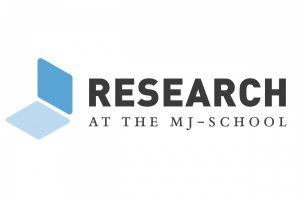Research Publication Roundup: April 2018

A vibrant and collaborative interdisciplinary research culture at the UNC Hussman School of Journalism and Media creates new knowledge, advances scholarship and helps reinvent media. Below is a list of recently published or presented scholarship by Hussman School faculty and students.
RECENT PUBLICATIONS
Parents of children with type 1 diabetes (T1D) face uncertainty about the illness. This uncertainty can have negative health consequences for parents and their children. However, little is known about the types of uncertainty associated with T1D diagnosis and subsequent treatment and how this uncertainty is managed. Using uncertainty management theory (UMT) as a framework and 29 in-depth interviews with parents of children with T1D, this study found that parents experienced medical, social, and financial forms of uncertainty. Most parents viewed uncertainty negatively and sought to reduce it by seeking information, joining support groups, and turning to technology. However, some parents preferred uncertainty to the certainty of knowing their child had T1D and, at least initially, chose to maintain uncertainty about the disease by avoiding information. This study also provides practical outcomes that health-care providers can use to help parents of children with T1D reduce and manage uncertainty.
HPV vaccination at the recommended ages of 11–12 is highly effective at preventing the acquisition of HPV type diseases that cause genital warts and cancers; yet vaccinations have stalled well below the goal of 80% of the population. We evaluated a statewide practice-based communication intervention to persuade parents, preteens and providers to vaccinate against HPV comparing vaccine initiation and completion rates over three 9-month periods (baseline, intervention, post-intervention) between practices enrolled in the intervention and a comparable comparison group. Of 175 eligible practices, the 14 intervention practices included 19,398 individuals and the 161 comparison practices included 127,896 individuals. An extended Cox model was used to test the intervention effect. Individuals in the intervention practices were 17% more likely to initiate and complete HPV vaccination than in the comparison practices during the intervention period and the effect was sustained post-intervention. This intervention is promising for increasing rates of HPV vaccination at ages 11–12.
From the quality of the air we breathe to the national leaders we choose, data and statistics are a pervasive feature of daily life and daily news. But how do news, numbers and public opinion interact with each other – and with what impacts on society at large? Featuring an international roster of established and emerging scholars, this book is the first comprehensive collection of research into the little understood processes underpinning the uses/misuses of statistical information in journalism and their socio-psychological and political effects.
Based on construal level theory, this research addresses the moderating role of an individual's psychological distance towards a disease in the effectiveness of advertising messages framed by two distinctive construal level terms (high-level and low-level). In Experiment 1, two different disease types (bronchitis/distant disease vs. influenza/proximal disease) were featured, with the result that an advertisement with high-level construal terms was more persuasive for a psychologically distant disease (bronchitis) than for a psychologically proximal disease (flu). The reverse was true for an ad framed with low-level construal terms. To replicate Experiment 1 and further test the hypothesis, in Experiment 2, the perceived distance individuals have towards one disease (cancer) was measured and used as an independent variable. Consistent with the results from Experiment 1, the low-level construal messages were more effective under the psychologically close condition than the psychologically distant condition. The reverse was true for the high-level construal messages.
The US Tobacco Control Act restricts advertising or labeling that suggests one tobacco product is less harmful than another. We sought to examine how “organic,” “natural,” and “additive-free” advertising claims and corresponding disclaimers affect perceptions of cigarettes’ harm. Participants viewed a Natural American Spirit cigarettes ad claiming they were “organic,” “natural,” “additive-free,” “light,” or “regular;” and with or without a corresponding disclaimer. The outcome was perceived harm of the advertised cigarettes. Among smokers, we also assessed interest in switching within their current brand to cigarettes with this characteristic (eg, “additive-free”). “Organic,” “natural,” and “additive-free” claims may mislead people into thinking that the advertised cigarettes are less harmful than other cigarettes. Disclaimers did not offset misperceptions of harm created by false claims. The US Food and Drug Administration should restrict the use of these misleading claims in tobacco advertising.